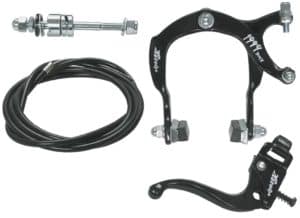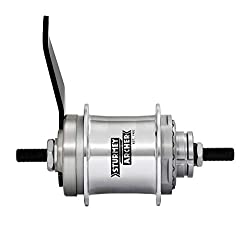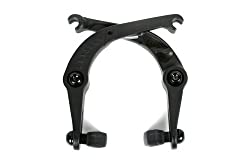The stopping power of a regular bike rests on the brake set. Squeeze the lever, the pad makes contact with the rim, the bike slows down, and you stop.
But the setup isn’t as obvious when it comes to BMX bikes. Built for highs-speed racing over short distance and for stunts, the discussion on speed control on a BMX bike is something completely different altogether. So do BMX bikes have brakes?

BMX bikes have rear brakes. Some models have both rear and front brakes and others feature only the front brakes. Rear brakes are the standard on many BMX bikes. The brake isn’t just for doing simple-complex stunts; it’s also an important component for keeping you safe.
Some BMX bike riders prefer to remove the brakes so they can do their tricks without worrying about brake cable getting in the way.
To be clear, those who strip away brakes from their BMX are advanced riders who have mastered the bmxing sports through months of practice and can easily control the speed of the bike without necessarily using the brakes.
But for the rest of us who are supposedly new to the sport, the brake is definitely necessary in aiding with speed control as well as stunt performance.
Why Do BMX Bikes Have Brakes?
Here’s why BM bikes have brakes:
1. The Law Requires BMX Bike to Have Brakes
Every state has cycling rules to which all roadies must adhere. That includes making sure their bikes have brakes.
In fact, riding any type of bike without brakes in the public is illegal and you could get a ticket for it or maybe even worse.
According to the US, UK, and Europe’s cycling laws, all BMX riders must equip their bikes with brakes for their safety and that of other road users, and failure to fit brakes on the bike can lead to a fine.
The law clearly indicates that brakes are significant because they enabled a cyclist to control speed and stop in the event of an emergency. And if you ride your BMX without brakes, then it’s your fault if you get into an accident.
Although US bike laws vary from state to state, the consensus is that a bike, regardless of the type, should have a brake on at least one wheel to allow a cyclist to stop.
2. BMX Have Brakes for Your Safety
We don’t just have brakes on bikes because the law requires us to. We also need them for our own safety as well as the safety of others.
If you think about it, our roads are busier than ever.
There are tens of vehicles moving at different speeds on different roads. Pedestrians are all over the place. And junctions and intersections are things to think about when moving from place to place.
The last thing you want when riding your BMX is to collide with people and objects, especially at junctions and areas where roads intersect.
Instead, you want to be able to control how fast you move depending on the nature of the trail and that’s possible only if you’ve fit the right brake set onto your BMX bike. With the brakes, you have the stopping power necessary to keep yourself and other road users safe.
Do BMX Bikes Need Brakes?
As a rule, all BMX bikes must have brakes to give riders effective stopping power, especially when cycling in public. Also, you can’t participate in organized bike racing if your BMX doesn’t have a rear brake.
There’s, however, an exception to this rule.
Freestyle BMX bikes dedicated to street or riding parks don’t necessarily need to have brakes. That explains why some of them come without brakes.
By completely stripping the brakes away from freestyle BMX bikes, experienced riders get the freedom to perform complex stunts and advanced techniques without having to reset their grips on the handlebars. Plus, the brake cables don’t get in the way, making it easy for them to transition from one trick to the next.
Keep in mind that going brakeless on a BMX isn’t for everyone. It’s for next-level riders who have mastered the ins and outs of bmxing through months, or even years, of experience.
What Type of Brakes Do BMX Bikes Have?
BM bikes have coaster brakes, U-brakes, and V-brakes, but the U-brakes are the current standard fixed onto many BMX models. It’s hard to come across a BMX bike that feature caliper brakes as manufacturers aren’t actively making them anymore.
The brakes are made of strong aluminum arms with the weight trimmed down to make the whole component as lightweight as possible.
Even the brake pads are available in different thickness and texture. Softer pads tend to provide the best grip, but if you want an option that last for long, tougher pads are your best bet.
1. Coaster (Pedal) Brakes

Mounted on the rear, coaster brakes activate when you reverse pedal a BMX bike. Coaster brakes aren’t popular these days and manufacturers are moving farther away from producing them.
Pedal brakes are good because they don’t feature cables that can easily get in the way when doing stunts and new tricks. Not to mention that the braking mechanism tends to be a little smooth and easy on the bike.
The problem is they hinder freestyle riding because they make adjusting pedals and splits almost impossible. Again, reverse pedaling a BMX bike with coaster brake slowly you down, which isn’t a good bmxing experience especially if you’re new to bicycle motocross.
2. V-Brakes
V-brakes were once common only to racing bikes, but now they are quite popular in the BMX category.

You activate V-brakes by cables, with the line of routing starting from the level at the handlebar all the way to the bottom bracket. Since they draw more cables when you press the lever, V-brakes tend to hold the rim tightly and provide better speed control.
V-brakes are lighter and powerful. But they tend to be a little less practical for freestyle BMX riders because they tend to contact the body of the rider.
3. U-Brakes
U-brakes are by far the most popular on BMX bikes. They’re not only sturdy with a straightforward structure. They also have the best cable management that you can find.

Thanks to the contoured design, the C-shaped arms that crisscross and arch over the tires, U-brakes tend to be farther away from contact with the BMX rider, so you do get a seamless riding experience and stunt performance.
BMX bikes with U-brakes make it easy for riders to perform some complex tricks such as 180 and 360 degrees quite well.
Do BMX Bikes Have Hand Brakes?
BMX bikes have hand brakes attached onto the handlebar. The type of brake can be either a V-brake or a U-brake, although the latter is often the most common type on most bikes.
As we’ve learned already, U-brakes have a sturdy structure and offer better cable management, which explain why they are quite popular on BMX bikes.
Do BMX Bikes Have Pedal Brakes?
If you’ve been on a 20-inch BMX bike or tried some 24-inch BMX bike, you may have noticed that pedaling backwards somewhat slows the bike.
That’s because these bikes have pedal brakes.
To be clear, not all BMX bikes have coaster hubs, and it’s highly unlikely that they’re popular as very few manufacturers integrate them to BMX.
U-brakes are currently the standard option hailed by many BMX riders.
Why Do BMX Bikes Only Have One Brake?
BMX bikes have only one brake because an additional would add extra weight to the bike. Also, brake cables can easily get in the way and make it difficult for you to do some tricks such as 180 and 360 degrees.
Why Don’t BMX Bikes Have Front Brakes?
BMX bikes don’t have front brakes because their presence would hinder better performance. With the front brake out of the way, riders can benefit from increased mobility. Not to mention the bike feels a little lighter than it would if it had both rear and front brakes.
Some cyclists, especially those who don’t like to deal with brake cables, see the front brake as a performance hindrance.
For what it’s worth, you want to be able to do your stunts without worrying about cords getting in the way. Often, the best option is to do away with the front brake if your BMX bike came with one.
Also Read:
Final Thoughts
On whether BMX bikes have brakes, the consensus is that you do need the brakes if you intend to ride the bike in public.
But even if you’re a freestyle BMX rider, having the rear break can go a long way to keep you safe. You just never know when you’ll need one.